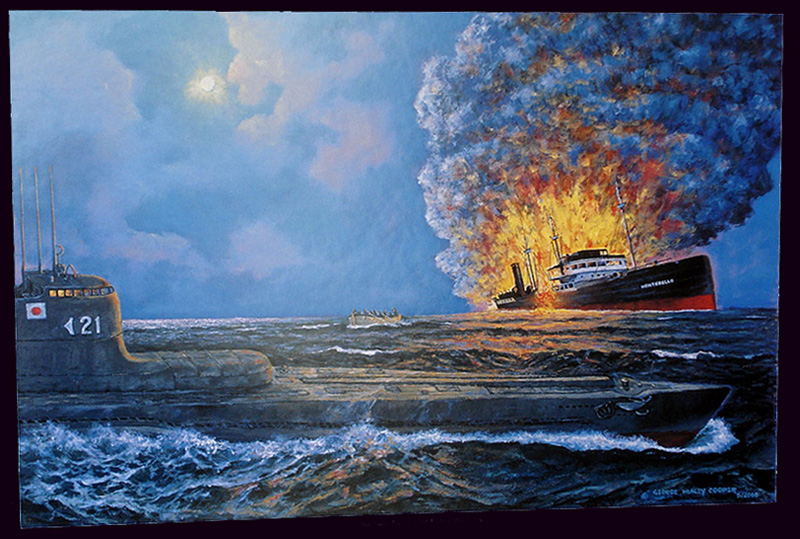 Artist rendering of the Montebello being torpedoed by a Japanese submarine
Artist rendering of the Montebello being torpedoed by a Japanese submarine
The S.S. Montebello is an oil tanker that was sunk off the coast of
California on Dec. 23, 1941 by a Japanese submarine during World War
II. The vessel is now in federal waters, approximately six miles off
the coast of Moonstone Beach in Cambria, 900 feet below the water’s
surface. Prior to its sinking, the Montebello loaded 73,571 barrels
(3,089,982 gallons) of Santa Maria crude oil and 2,477 barrels (104,034
gallons) of bunker fuel at Port San Luis, California.
On December 23, 1941, amid multiple reports of Japanese submarine
sightings, Montebello Captain Mogens Andreasen resigned his post, leaving
command of the ship to First Mate Olof Ekstrom. Ekstrom and the crew
of the Montebello knew there were Japanese submarines off the California
coast, but they voted to ship out on the oil tanker anyway.
The Montebello
departed at 1:30 a.m. and headed towards it's destination of Vancouver,
British Columbia. At 5:30 a.m. Ordinary Seamen William Srez and Richard
Quincy, on watch aboard Montebello, alerted Captain Ekstrom that they
were being stalked by what looked like a sub. A few moments later the
rising sun silhouetted the trailing vessel off the port quarter, Srez
and Quincy realized it was an I-21 Japanese submarine low in the water.
The I-21 then repositioned to the starboard quarter between the tanker
and mainland and fired a single torpedo into the Montebello. Incredibly,
the torpedo hit the only compartment not loaded with oil or gasoline. "The
men wouldn't have had a chance if any other hold was hit," said
Ekstrom. But it did knock out the radio.
At 5:55 the Captain gave the order to abandon ship. Recalling the
Captain’s demeanor during those chaotic moments after the ship
was hit, the crew said, “The Captain was as cool as a snow drift.” All
thirty-eight crewmen left the tanker in four lifeboats as the I-21
opened fired on the boats with its deck gun. No one was hit by gunfire,
but the lifeboat carrying the Captain was hit, and began leaking badly.
The lifeboats finally pulled away safely from the tanker as the submarine
descended below the surface to avoid detection from reconnaissance
aircraft. The crew watched the tanker settle in the bow, submerging
below the surface at 6:45 a.m. As the bow started downward, the crew
witnessed the stern clearing the ocean surface by 150 feet (45 meters).
They concluded the tanker was struck amidships around the No. 3 tank,
but couldn’t understand why the cargo - with a Grade A Flash
point at room temperature - did not ignite? The crew speculated the
torpedo struck between decks above the oil storage tanks.
The crew rowed for the next six hours till they finally reached the
rocky coast just south of Cambria, California. All crew members survived.